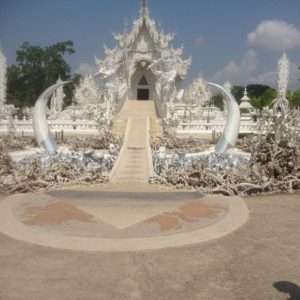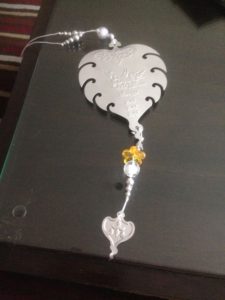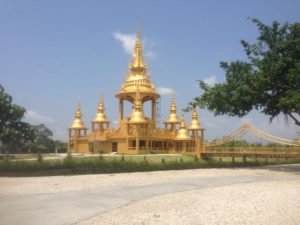Chiang Rai was founded by Phaya Mengrai in 1262 as as the capital of the Mengrai Dynasty (part of the Lao–Thai Lanna kingdom), Chiang Rai didn’t become a Siamese territory until 1786 and a province until 1910.
In the morning, we boarded trucks for our drive into the hill country to visit an area where 4 hill tribes live. The various hill tribes have moved down from China and Burma to avoid persecution. Over a million live near the Thai border with Myanmar. Traditionally, they grew poppies for opium but now with the support of local people and NGO’s, they support themselves through agriculture and selling handcrafts to those who visit their villages. Although they are desperately poor, they are safe in Thailand, and they have basic necessities and a small school for their children. Many of us felt uncomfortable with the idea of human tourism, but in the end we learned a great deal and felt we were able to contribute to their income in some small way. We all either bought something or left bills in the contribution boxes for the school and for each tribe.
The first tribe we visited was the Akha tribe. There is no electricity in the villages, and the people live in bamboo and thatched shelters set a few feet off the ground.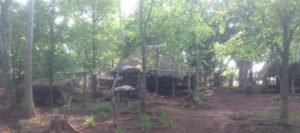 They wear beautiful silver jewelry with elaborate headdresses, necklaces and hand pieced clothing and leggings. The woman we bought a wind chime from was in her mid eighties.
They wear beautiful silver jewelry with elaborate headdresses, necklaces and hand pieced clothing and leggings. The woman we bought a wind chime from was in her mid eighties. 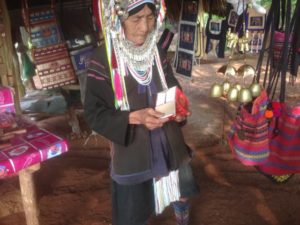 In this tribe twins are considered bad luck and are killed at birth. The majority of this tribe seemed to be old women (the men would be out working in the fields).
In this tribe twins are considered bad luck and are killed at birth. The majority of this tribe seemed to be old women (the men would be out working in the fields).
The women performed a chant for us accompanied by the rhythmic beating of bamboo on a log.
The Akha make the intricate pieced bags, hats, and water bottle carriers that resemble Seminole handiwork. The colors represent the colors of poppies.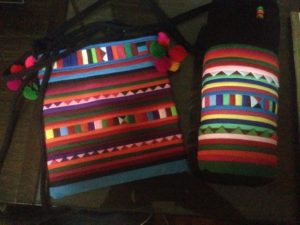
In the thatched communal building, there were birds nesting in the thatch.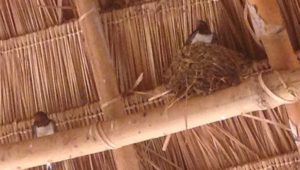
The next area had four tribes represented, the big earring tribe, the long neck tribe (both part of the Karen group), the Lahu-Muser (Lahu), and the Lu-mien Yao (Yao). The tribes seemed to share a herd of water buffalos. 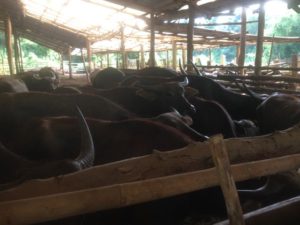
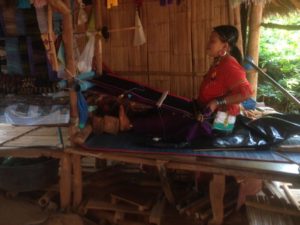 Most of the women wove scarves on simple looms. Almost all of the houses were built on platforms with bamboo plank walls and thatched roofs. The kids were all adorable.
Most of the women wove scarves on simple looms. Almost all of the houses were built on platforms with bamboo plank walls and thatched roofs. The kids were all adorable.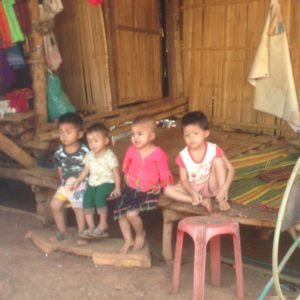
They have a one room school house. The children assembled to sing a song.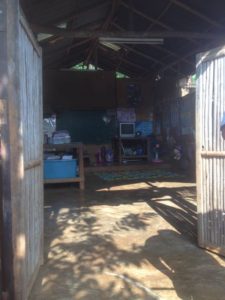
We brought all the toiletries from our hotel rooms and Ron brought gifts of milk and cookies for each of the children. 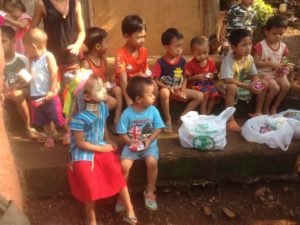
The women of the long neck tribe have brass could wrapped around their necks from the time they are young. The custom originated in a tiger attack and a sorceress who said the way to prevent it was to protect their necks with coils (originally gold but now brass). Coils are added as the women get older. The coils compress the shoulders and chest, so taking the off later in life is dangerous because their necks are weak. The coils weigh more than five pounds and seem barbaric, but they are a part of their culture. The Thai government has said that if the children are to go to school, they cannot wear neck coils, which will free the girls from a certain physical bondage, but by the same token their culture will disappear. As Ron said, who knows whether it is right or wrong. The NGO’s are trying to improve the life of the people and certainly they have a better life in Thailand, where they are safe, than they did in Myanmar.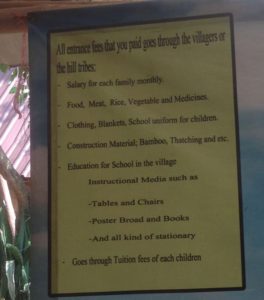
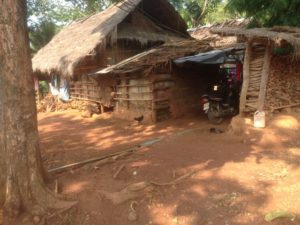 As we were leaving, they were letting the water buffalos out of the coral and taking them down to the water, which was fascinating to see.
As we were leaving, they were letting the water buffalos out of the coral and taking them down to the water, which was fascinating to see.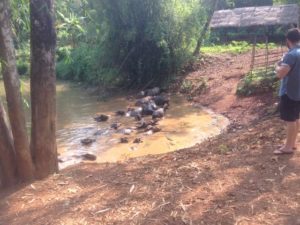
Wat Rong Khun / White Temple
We were lucky to arrive before the crowds and had the temple almost to ourselves. It is one of the most fantastical sites we have seen.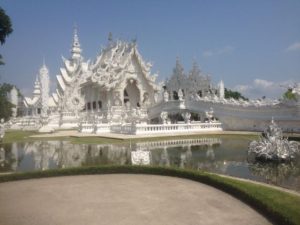
This modern Buddhist temple was begun in 1998 by artist Chaloemchai Kositpipat and is an ongoing project with ornamentation and building being added all the time.
It is similar to Gaudi’s Sagrada Familia in Barcelona because it remains under construction. The main chapel won’t be completed until 2020, and eventually, Wat Rong Khun will have a total of nine structures.
Carved in the pure white, the ornate facade and path leading to the entrance are filled with fanciful creatures, images, and hands.
You can only enter the ubosot (main chapel) from the front, via the narrow bridge that passes over a pool of upturned, beseeching hands representing suffering souls in hell. 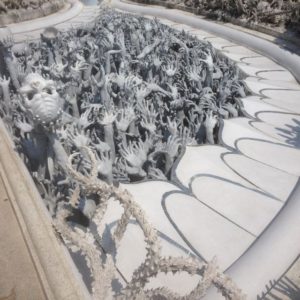 From here, there’s no turning back, as the only way is to ascend ‘heavenwards.’
From here, there’s no turning back, as the only way is to ascend ‘heavenwards.’
Inside, two Buddha images seem to be floating on a lotus pedestal, set against elaborately painted murals in which Chalermchai incorporates figures from modern culture, such as spaceships, superman, and even Neo from the Matrix movie to tell the stories of the Buddha’s life and his teachings.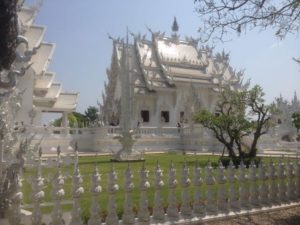
On the outside of the temple are the wishing trees, 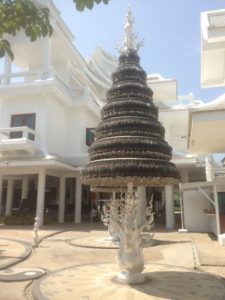 millions of wishes inscribed on metal leaves and hung on the roofs of colo
millions of wishes inscribed on metal leaves and hung on the roofs of colo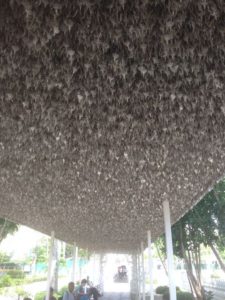 nades. We all bought leaves (30 baht each) and hung them on one of the trees.
nades. We all bought leaves (30 baht each) and hung them on one of the trees.
One of the most amazing things about this site is that is that each piece of ornamentation on unique as you can see from the mythological figures that surround the wishing well.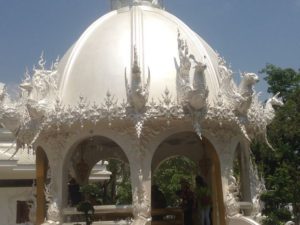
Clearly, buildings are being built and decorated all the time.
On our way to lunch, we stopped at a local rice mill that uses machinery made of teak. Human hands never touch the rice as it is husked and polished and dropped into rice sacks.
We ate lunch at Cabbages and Condoms, a non-profit that raises money to support family planning.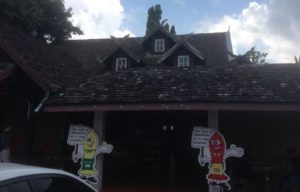
Notice the distinctive Chiang decorations on the peaks of the roof.
From there we drove to Chiang Mai, the third largest city in Thailand (2.5 million people). The temperatures are cooler in the winter and the cost of living and housing is lower than in Bangkok, which is only a one hour flight away. It is also a favorite city for ex-pats.
Chiang Mai was founded in 1276 as the second capital of the Lanna Kingdom (after Chiang Rai). The emerald Buddha that we saw in Bangkok was originally located in Chiang Rain, then moved to Chiang Rai when the capital moved. When the Burmese took over, the king of Laos took it and it remained in Laos for 200 years until the Thai king attacked Laos in 1179 and took it back. It has remained in Bangkok ever since. The Lanai kingdom became part of Siam when King Rama V married a Lanna princess.





